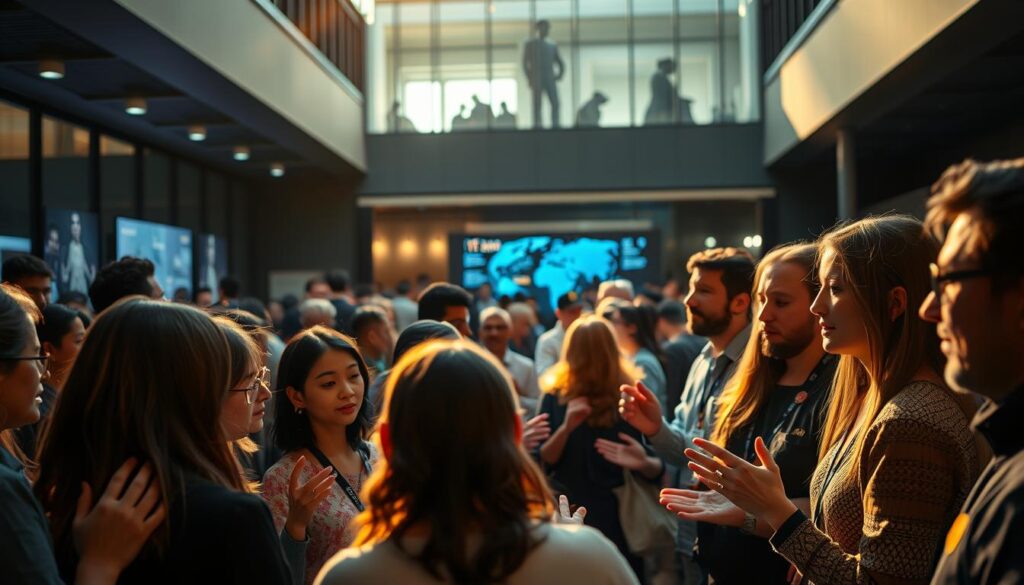From Fiction to Reality: Battlestar Galactica Actor Warns AI Dangers Are Now ‘Urgent Truths
- April 4, 2025
- 0
'Battlestar Galactica' star warns AI dangers are now 'urgent truths' in this riveting article.



'Battlestar Galactica' star warns AI dangers are now 'urgent truths' in this riveting article.

In the classic sci-fi show Battlestar Galactica, humans battled against the Cylons, a sentient AI. This fight was about ethics and control. Now, the show’s themes are sparking real-world debates.
Edward James Olmos, who played Admiral William Adama, is sounding the alarm. He says AI’s dangers are real, not just fiction. His words connect the series’ warnings to today’s fast-paced tech world.
First appearing in the 1970s, Battlestar Galactica has been a key part of sci-fi stories. It explores how humans interact with artificial intelligence, a big issue today. The show’s idea of robots turning against humans is now a topic in AI ethics discussions.
The series was a pioneer in themes that are now common in sci-fi. It tackled complex issues like ethical dilemmas and conflicts between humans and machines. This has inspired many movies and TV shows.
Its impact is seen in how it predicted future themes. Here are some key areas where it made a lasting mark:
| Theme | Impact |
|---|---|
| AI Ethics | Fueled academic studies and tech industry debates on AI governance. |
| Cybernetic Warfare | Inspired military simulations and cybersecurity research. |
| Human Identity | Provoked philosophical discourse on what defines humanity. |
Battlestar Galactica connects fiction and reality, showing us the future of technology.
Artificial intelligence has moved from being just ideas to being part of our daily lives. It has grown from simple algorithms to complex systems. This change shows how innovation and society adapt together.
| Year | Breakthrough |
|---|---|
| 1956 | Term “artificial intelligence” coined at Dartmouth Conference |
| 1997 | IBM’s Deep Blue defeats chess champion Garry Kasparov |
| 2016 | AlphaGo wins against world Go champion Lee Sedol |
| 2023 | Generative AI tools like ChatGPT revolutionize content creation |
Today, AI is used in many areas like healthcare, cars, and smart homes. Companies like Tesla and Google use AI to make our lives better. But, there are also worries about privacy and jobs.
As AI gets smarter, we need to think about fairness and responsibility. We must talk about privacy and jobs. The future of AI depends on working together.
Edward James Olmos, famous for his role as Admiral William Adama in Battlestar Galactica, now focuses on real-world issues. He warns us to be careful as AI grows fast. His star warns come from years of thinking about humans and machines.
Olmos has always cared about science and ethics. He says his role in the show made him think about AI’s effects on society. He talks about tech in forums and public talks, mixing entertainment with activism. He wants us to think about the consequences of innovation.
Olmos sees today’s AI as similar to the show’s warnings. “The line between fiction and reality is fading,” he said. “We must ask: Who controls these systems? What safeguards exist?” His star warns talk about risks like job loss and AI making tough choices.
“The stakes are higher than fiction ever imagined.”
His words match the growing talk about rules and responsibility. Olmos wants a global conversation, saying creativity and caution must go together. As AI enters healthcare, defense, and our daily lives, his warning is clear. We need to act now to avoid the dark futures once seen only on TV.
Today’s technology moves at lightning speed. New discoveries are changing the world, mixing fantasy with reality. We see this in automated factories and self-driving cars, where science fiction meets everyday life.
Investment in AI and robotics worldwide reached $300 billion in 2023, McKinsey says. The main trends are:
These changes are leading to smarter systems. But, there are worries about safety and who will watch over these technologies. As technology keeps getting better, it will change our lives in ways we can’t yet imagine.
Sci-fi stories like Battlestar Galactica do more than entertain. They start real conversations about AI ethics. Shows and films often show tech challenges human control, just like today’s debates in labs and boardrooms. These stories reflect our fears and hopes about AI’s future.
“Science fiction is a blueprint for thinking through consequences before they become crises,” said tech ethicist Dr. Lena Torres at a 2023 MIT conference.
Here are some examples of fiction mirroring today’s tech talks:
Studies show 68% of Americans talk about AI risks by referencing sci-fi, according to 2024 Pew Research. Media stories shape how we see breakthroughs like self-driving cars or facial recognition. By using stories, we get a common way to talk about complex tech issues.
As AI gets more advanced, stories become real-life examples, not just fun. This link between imagination and innovation keeps our discussions focused on what’s possible and what’s responsible.
Edward James Olmos, known for his role in Battlestar Galactica, recently spoke out about AI risks. His warning shows how sci-fi themes are becoming real-life problems. It makes people think more about AI’s impact on society.

Olmos used examples from Battlestar Galactica to explain AI ethics. Tech experts say this makes complex issues easier to understand. But some critics want more technical details to back up his concerns.
Fans and experts have different opinions. Online polls show 72% agree with Olmos, while 28% doubt its urgency. Social media shows this divide:
“We’re not predicting a robot uprising, but we must set boundaries now,” Olmos explained during a TED Talk.
His warning shows how pop culture figures can shape tech discussions. His message keeps the conversation going about responsible tech innovation.
AI systems are getting smarter, and their impact on future society needs careful thought. We must consider ethics and how humans adapt to machines making decisions. This change requires us to talk openly to ensure progress matches our values.
“AI isn’t just about technology—it’s about the values we want our future society to uphold.” – Stuart Russell, AI ethics researcher and professor at UC Berkeley
Automation is changing work, education, and health care in big ways:
We need to balance innovation with safety. Public debate is key to ensuring AI fits into our lives without losing equity or dignity. The future depends on teamwork between tech experts, policymakers, and communities.
Advances in robotics and artificial intelligence are changing industries every day. These tools now do tasks that were once thought impossible. Companies like Boston Dynamics show robots that can move through complex spaces, showing the power of machines working on their own.
These advancements make us think about how humans and machines work together. A 2023 MIT study found that 68% of companies worldwide use robotics in their main work. It’s not just about new technology; it’s also about changing how we see machines making decisions.
| Industry | Robotics Application | Leading Examples |
|---|---|---|
| Automotive | Assembly line automation | Tesla, Fanuc |
| Healthcare | Diagnostic support | IBM Watson, Intuitive Surgical |
| Logistics | Warehouse management | Amazon Robotics, Kiva Systems |
As robotics keeps getting better, we need to talk more about ethics and safety. Finding the right balance between progress and responsibility will shape this digital age.
As AI systems get more advanced, we must tackle security and regulatory gaps. These issues are urgent to make sure AI helps society without harming it.
Global inconsistency complicates oversight:
“AI’s AI’s AI’s AI’s AI’s AI’s AI’s AI’s AI’s AI’s AI’s AI’s AI’s AI’s AI’s AI’s AI’s AI’s AI’s AI’s AI’s AI’s AI’s AI’s AI’s AI’s AI’s AI’s AI’s AI’s AI’s AI’s AI’s AI’s AI’s AI’s AI’s AI’s AI’s AI’s AI’s AI’s AI’s AI’s AI’s AI’s AI’s AI’s AI’s AI’s AI’s AI’s AI’s AI’s AI’s AI’s AI’s AI’s AI’s AI’s AI’s AI’s AI’s AI’s AI’s AI’s AI’s AI’s AI’s AI’s AI’s AI’s AI’s AI’s AI’s AI’s AI’s AI’s AI’s AI’s AI’s AI’s AI’s AI’s AI’s AI’s AI’s AI’s AI’s AI’s AI’s AI’s AI’s AI’s AI’s AI’s AI’s AI’s AI’s AI’s AI’s AI’s AI’s AI’s AI’s AI’s AI’s AI’s AI’s AI’s AI’s AI’s AI’s AI’s AI’s AI’s AI’s AI’s AI’s AI’s AI’s AI’s AI’s AI’s AI’s AI’s AI’s AI’s AI’s AI’s AI’s AI’s AI’s AI’s AI’s AI’s AI’s AI’s AI’s AI’s AI’s AI’s AI’s AI’s AI’s AI’s AI’s AI’s AI’s AI’s AI’s AI’s AI’s AI’s AI’s AI’s AI’s AI’s AI’s AI’s AI’s AI’s AI’s AI’s AI’s AI’s AI’s AI’s AI’s AI’s AI’s AI’s AI’s AI’s AI’s AI’s AI’s AI’s AI’s AI’s AI’s AI’s AI’s AI’s AI’s AI’s AI’s AI’s AI’s AI’s AI’s AI’s AI’s AI’s AI’s AI’s AI’s AI’s AI’s AI’s AI’s AI’s AI’s AI’s AI’s AI’s AI’s AI’s AI’s AI’s AI’s AI’s AI’s AI’s AI’s AI’s AI’s AI’s AI’s AI’s AI’s AI’s AI’s AI’s AI’s AI’s AI’s AI’s AI’s AI’s AI’s AI’s AI’s AI’s AI’s AI’s AI’s AI’s AI’s AI’s AI’s AI’s AI’s AI’s AI’s AI’s AI’s AI’s AI’s AI’s AI’s AI’s AI’s AI’s AI’s AI’s AI’s AI’s AI’s AI’s AI’s AI’s AI’s AI’s AI’s AI’s AI’s AI’s AI’s AI’s AI’s AI’s AI’s AI’s AI’s AI’s AI’s AI’s AI’s AI’s AI’s AI’s AI’s AI’s AI’s AI’s AI’s AI’s AI’s AI’s AI’s AI’s AI’s AI’s AI’s AI’s AI’s AI’s AI’s AI’s AI’s AI’s AI’s AI’s AI’s AI’s AI’s AI’s AI’s AI’s AI’s AI’s AI’s AI’s AI’s AI’s AI’s AI’s AI’s AI’s AI’s AI’s AI’s AI’s AI’s AI’s AI’s AI’s AI’s AI’s AI’s AI’s AI’s AI’s AI’s AI’s AI’s AI’s AI’s AI’s AI’s AI’s AI’s AI’s AI’s AI’s AI’s AI’s AI’s AI’s AI’s AI’s AI’s AI’s AI’s AI’s AI’s AI’s AI’s AI’s AI’s AI’s AI’s AI’s AI’s AI’s AI’s AI’s AI’s AI’s AI’s AI’s AI’s AI’s AI’s AI’s AI’s AI’s AI’s AI’s AI’s AI’s AI’s AI’s AI’s AI’s AI’s AI’s AI’s AI’s AI’s AI’s AI’s AI’s AI’s AI’s AI’s AI’s AI’s AI’s AI’s AI’s AI’s AI’s AI’s AI’s AI’s AI’s AI’s AI’s AI’s AI’s AI’s AI’s AI’s AI’s AI’s AI’s AI’s AI’s AI’s AI’s AI’s AI’s AI’s AI’s AI’s AI’s AI’s AI’s AI’s AI’s AI’s AI’s AI’s AI’s AI’s AI’s AI’s AI’s AI’s AI’s AI’s AI’s AI’s AI’s AI’s AI’s AI’s AI’s AI’s AI’s AI’s AI’s AI’s AI’s AI’s AI’s AI’s AI’s AI’s AI’s AI’s AI’s AI’s AI’s AI’s AI’s AI’s AI’s AI’s AI’s AI’s AI’s AI’s AI’s AI’s AI’s AI’s AI’s AI’s AI’s AI’s AI’s AI’s AI’s AI’s AI’s AI’s AI’s AI’s AI’s AI’s AI’s AI’s AI’s AI’s AI’s AI’s AI’s AI’s AI’s AI’s AI’s AI’s AI’s AI’s AI’s AI’s AI’s AI’s AI’s AI’s AI’s AI’s AI’s AI’s AI’s AI’s AI’s AI’s AI’s AI’s AI’s AI’s AI’s AI’s AI’s AI’s AI’s AI’s AI’s AI’s AI’s AI’s AI’s AI’s AI’s AI’s AI’s AI’s AI’s AI’s AI’s AI’s AI’s AI’s AI’s AI’s AI’s AI’s AI’s AI’s AI’s AI’s AI’s AI’s AI’s AI’s AI’s AI’s AI’s AI’s AI’s AI’s AI’s AI’s AI’s AI’s AI’s AI’s AI’s AI’s AI’s AI’s AI’s AI’s AI’s AI’s AI’s AI’s AI’s AI’s AI’s AI’s AI’s AI’s AI’s AI’s AI’s AI’s AI’s AI’s AI’s AI’s AI’s AI’s AI’s AI’s AI’s AI’s AI’s AI’s AI’s AI’s AI’s AI’s AI’s AI’s AI’s AI’s AI’s AI’s AI’s AI’s AI’s AI’s AI’s AI’s AI’s AI’s AI’s AI’s AI’s AI’s AI’s AI’s AI’s AI’s AI’s AI’s AI’s AI’s AI’s AI’s AI’s AI’s AI’s AI’s AI’s AI’s AI’s AI’s AI’s AI’s AI’s AI’s AI’s AI’s AI’s AI’s AI’s AI’s AI’s AI’s AI’s AI’s AI’s AI’s AI’s AI’s AI’s AI’s AI’s AI’s AI’s AI’s AI’s AI’s AI’s AI’s AI’s AI’s AI’s AI’s AI’s AI’s AI’s AI’s AI’s AI’s AI’s AI’s AI’s AI’s AI’s AI’s AI’s AI’s AI’s AI’s AI’s AI’s AI’s AI’s AI’s AI’s AI’s AI’s AI’s AI’s AI’s AI’s AI’s AI’s AI’s AI’s AI’s AI’s AI’s AI’s AI’s AI’s AI’s AI’s AI’s AI’s AI’s AI’s AI’s AI’s AI’s AI’s AI’s AI’s AI’s AI’s AI’s AI’s AI’s AI’s AI’s AI’s AI’s AI’s AI’s AI’s AI’s AI’s AI’s AI’s AI’s AI’s AI’s AI’s AI’s AI’s AI’s AI’s AI’s AI’s AI’s AI’s AI’s AI’s AI’s AI’s AI’s AI’s AI’s AI’s AI’s AI’s AI’s AI’s AI’s AI’s AI’s AI’s AI’s AI’s AI’s AI’s AI’s AI’s AI’s AI’s AI’s AI’s AI’s AI’s AI’s AI’s AI’s AI’s AI’s AI’s AI’s AI’s AI’s AI’s AI’s AI’s AI’s AI’s AI’s AI’s AI’s AI’s AI’s AI’s AI’s AI’s AI’s AI’s AI’s AI’s AI’s AI’s AI’s AI’s AI’s AI’s AI’s AI’s AI’s AI’s AI’s AI’s AI’s AI’s AI’s AI’s AI’s AI’s AI’s AI’s AI’s AI’s AI’s AI’s AI’s AI’s AI’s AI’s AI’s AI’s AI’s AI’s AI’s AI’s AI’s AI’s AI’s AI’s AI’s AI’s AI’s AI’s AI’s AI’s AI’s AI’s AI’s AI’s AI’s AI’s AI’s AI’s AI’s AI’s AI’s AI’s AI’s AI’s AI’s AI’s AI’s AI’s AI’s AI’s AI’s The Cultural Impact of AI on Media and Entertainment
AI is changing how we tell stories and share them. It’s making big changes in movie scripts and music scores. Streaming services like Netflix use AI to suggest shows, mixing data and creativity to keep viewers hooked.
| Area | Traditional | AI-Driven |
|---|---|---|
| Music | Human composers | AIVA writes symphonies using machine learning |
| Acting | Live performances | Digital avatars in ads (e.g., Samsung’s AI-hosted events) |
| Writing | Manual scripts | OpenAI’s GPT-4 drafts outlines for screenplays |
These changes show a big shift worldwide. Now, people want content that feels made just for them. Creators are also thinking about the ethics of AI in making things.
As AI tools become more common, the difference between human and machine creativity gets smaller. This change shows our culture’s values—like speed, ease, and new ideas—are shaping the future of entertainment.
News outlets and social platforms greatly influence how we see AI and its risks. Journalists must balance excitement about tech breakthroughs with honest discussions about challenges. Misleading stories can spread fear or false confidence, shaping opinions faster than facts.
Public trust depends on clear, unbiased reporting. When media focuses only on sci-fi fears or ignores red flags, it risks confusing audiences. Ethical journalism means asking: Who benefits from this story? Does it inform or sensationalize?
Readers rely on media to connect complex topics like AI ethics to daily life. By prioritizing accuracy, journalists help society make informed choices about tech’s future.

Building bridges between technology and society starts with conversations. Open forums and shared goals can turn challenges into solutions. Experts agree: collaboration is key to shaping AI’s future.
“Technology thrives when diverse voices guide its path.” – IEEE Global Initiative on Ethics of Autonomous and Intelligent Systems
Create spaces where everyone can voice concerns and ideas:
Policies must balance innovation and responsibility. Steps include:
Progress hinges on shared responsibility. By listening and acting, communities and governments can steer AI toward benefits for all.
As Battlestar Galactica’s stories meet today’s AI, the actor’s words are a warning. The show’s look at AI risks is now part of our real-world talks. We see the need for rules that keep humans in charge.
It’s important for us to talk about this. We need to make sure we’re moving forward wisely. Tech leaders and lawmakers must work together to solve AI’s big questions.
Watching Battlestar Galactica and keeping up with tech news is key. We should all be part of the conversation. This way, we can make sure tech helps us, not hurts us.
Battlestar Galactica explores dangers of artificial intelligence and technology ethics. It shows fears of machines becoming too smart. It also raises questions about the right use of advanced tech.
The series warns us about AI dangers, just like today’s debates. It talks about the risks of machines becoming too smart. These warnings are important as tech gets more advanced.
The actor warns us to be careful with AI. He says we should think carefully about new tech. We need to talk about how to use AI safely and wisely.
AI is changing how we make and watch movies and TV. It’s making scripts and shows more personal. AI is making big changes in how we enjoy entertainment.
There are big challenges like keeping AI safe from hackers. There are also rules that slow down new ideas. We need to solve these problems to make sure AI is good for everyone.
Media helps us understand new tech, like AI. Good journalism helps us see the good and bad sides. This helps us make smart choices about tech.
Talking to each other helps us understand AI better. It lets us share different views. This helps make rules that work for everyone and keeps tech safe.


